BEYOND Expo 2025: Robotics and more robotics. LLMs are still looking to "go-global"
From Flying Cars to Factory Floors, Macau Expo Signals New Tech Cycle and China AI's Global Ambitions
Hi guys,
I have quite a few things on my mind.
FT: Chinese battery maker CATL surges 16% in biggest listing of 2025
Google’s series of announcements at its I/O event disrupts startup dreams. (I have a piece brewing on this.)
Sovereign AI is becoming more and more of a real thing after a year of chit-chat.
But before we dive deep into any of those in the next two weeks, I want to quickly share some interesting insights from the BEYOND Expo in Macau last week.
I took a ferry from Hong Kong to Macau last Friday, where the Beyond Expo 2025 was held at the Venetian Macao Cotai Expo (May 21 - 24), and it was much better than I expected. As for the quality of the panels, both the speakers and moderators were able to discuss industry trends and share what is at the top of industry practitioners' and investors' minds.
For some context, BEYOND Expo marked its fifth year and was its largest in scale yet. Organisers billed it as Asia’s largest innovation-and-technology gathering, drawing 30,000-plus attendees, 1,200+ exhibitors, and 300+ speakers. It is said to want to position itself as the Asia CES.
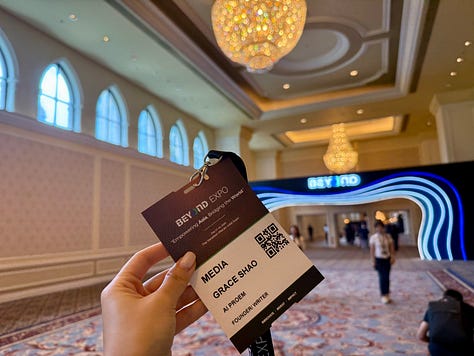

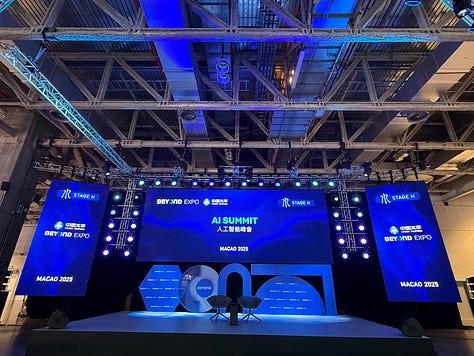
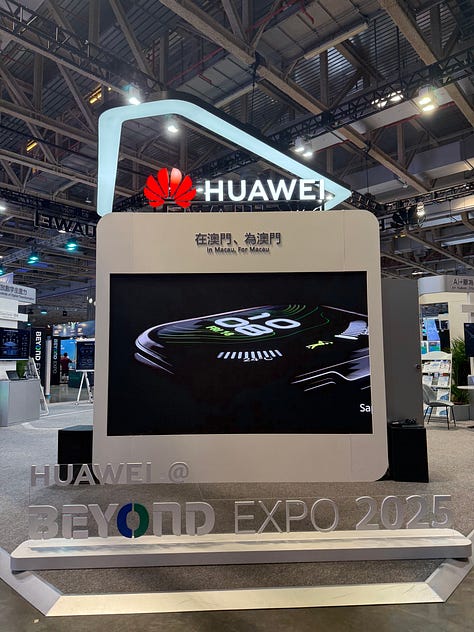
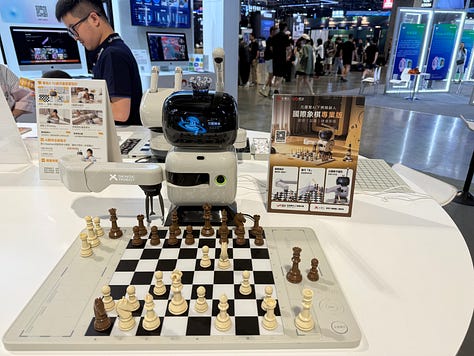
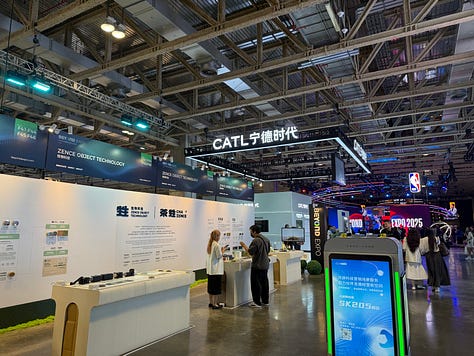
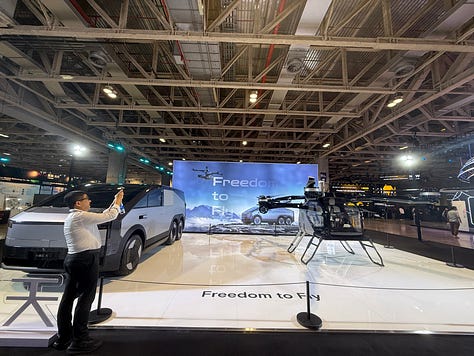
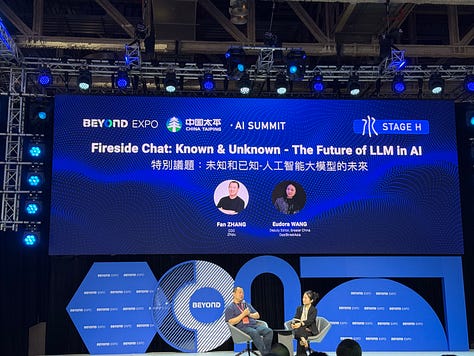
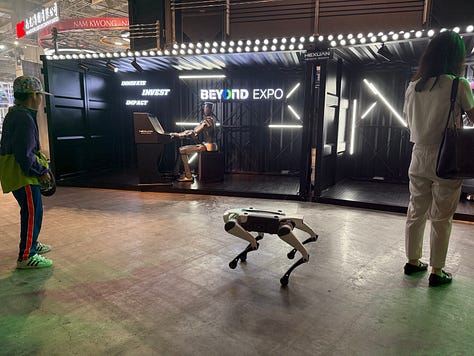
For me, the two key themes stood out - the buzz centered on two questions: How soon can humanoid robots leave the laboratory, and how will large-language-model makers manage to expand beyond China’s borders at scale?
Beyond Expo 2025
I have also been to a few of these types of events in Hong Kong and Shanghai recently, but I think this definitely exceeded my expectations. I mostly sat at the AI Summit and met with some of the start-up founders, many of whom were from Shenzhen (just 1 hour away from Macau and HK by ferry/ driving). But I was also pleasantly surprised to see that there were two big delegations from South Korea and Japan, as well, showcasing their innovation at the exhibition.
The quality of the speakers stood out at this event because they all used their mother tongue (Mandarin, Cantonese, English, etc.), and simultaneous translation was offered by iFlytech on the big screens beside the panels. Despite some nuances and technical language not being translated accurately, it was a glimpse into the future. Instead of making everyone use English for the panel discussions, which can sometimes really be a hurdle in getting the best speakers or even having the speakers sound the most confident, this approach was quite refreshing for an international conference. A few big names appeared, from NBA star Yao Ming to Alibaba Chairman Joe Tsai.
In fact, Joe Tsai said at the event: “There’s actually a lot of inter-Asia business activity, engagement that can happen among the East Asian countries between East Asia, and Southeast Asian, and eventually South Asia as well.” And echoing what many startup founders have said to me is that Europe is “an incredible opportunity” for Asian (Chinese) companies in this era. Adding that Europeans may be more nuanced when dealing with China and not as “black and white” as the Americans.
At the Opening Ceremony, the opening panel included Dr. Jian Wang, President, Zhejiang Lab; Founder, Alibaba Cloud; Carl Pei, Co-founder & CEO, Nothing; Dr. Burt Guo CEO & Chief Scientist; Sichuan Aerofugia Technology Development CO., LTD; Zhaopeng Chen, CEO & Founder at Agile Robots SE, and Jingkang Liu, Founder, Insta360.
Now, I’m really looking forward to the WAIC event in Shanghai this coming July, especially given the interest from global investors and media in the space in China now, especially after the DeepSeek disruption. I’ve seen people posting about organizing delegations to visit Shanghai and Hangzhou from the U.S. around that time, and many Chinese AI startups are definitely getting ready to court and impress.
A few high-level observations from the event
There were numerous humanoid and quadruped robotic companies. Prices varied, and the maturity of their GTM varied, but on the very surface level, they all seemed to be able to do somewhat the same thing. It’s a use-case and price battle now.
The big players attended and showcased their strengths in their years of leading vertical technologies. iFlytech sponsored the event’s simultaneous translation, with the big screens throughout the exhibition halls showing English or Chinese, depending on the speaker’s language. XPeng had a big display of its EVs and flying cars.
I really appreciated candid conversations led by industry leaders such as Zhipu’s COO, UBTech’s CBO, and many more. Got a quick snap in with Fan ZHANG, Zhipu’s COO and a quick chat.
The hardware display seemed to attract more attention - maybe it was just easier to visualize. Smart glasses, medical use robots, facial scanning AI psychologists, robot ice cream maker, coffee arm, and more.
Many exhibitors were fre$h startups that just broke off from their university labs, notably Hexuan, a quadruped and robotics company that sells these for about ~500k RMB (80k USD) that can play the piano. The founder and team just broke off from Zhejiang University (the alma mater of DeepSeek’s Liang Wenfeng).
Other startups like Finnox use a camera to detect the nuanced moves in your facial expressions. They have just started collaborating with local psychological clinics in Shenzhen and have started formal fundraising. Most have not gone to market nor are even trying to scale at this point, and this leads into an interesting conversation with the UBtech Robotics CBO, Michael Tam. (see below)
Robots and more robots
Paraphrasing and translating some of UBtech Chief Brand Officer, Michael Tam’s key points on the development of humanoid robotics
LLM technology is still at its very early stage of support in the humanoid adoption. What it means is that while LLMs hold great promise for enhancing robot intelligence and adaptability, their practical application in humanoid robots is still nascent and only at the “front-end” so far.
When the moderator asked whether the current industry can see more standardization and regulation, he said it would be incredibly hard to enforce industry standardization right now because “99% of companies are still in the laboratory stage.”
He sees more possibility in vertical use cases being standardized through practical trials and errors in the coming years.
UBtech Robotics has spent the last 18 months focused on manufacturing use cases and has already submitted indexes and industrial verification applications to 工信部 Ministry of Industry and Information Technology.
He believes this is a moment of tech convergence and there is a lot to look forward to. However, the biggest challenge people overlook is the lack of physical 3D data. The company is collecting data and then using that physical data to train its robots in scenario training settings, and hopefully, these robots can scale.
Tam said that the company is building the dataset from the ground up and believes that manufacturing will see mass-scale adoption on the production lines. Ultimately, the current 3D world is built for human form, so humanoid form will be the best for integrating into real-life scenarios.
He highlighted the March collaboration launch between UBTech and Zeekr, which showed the potential of multi-bot collaboration, and this is where he sees the future of manufacturing adoption will look like, but in a more sophisticate,d seamless way.
As the robots can already plug themselves into the sockets for fast-speed charging, if these robots can work 24/7 in the dark, then the efficiency at certain tasks will outpace human efficiency.
I appreciated his realness in the technological development. Instead of hyping it all up, he said that the humanoid robotics household adoption will take at least ~5 years to reach commercial scale, and even when it does, likely it will perform more companion-like roles rather than replacing service roles. For example, helping children with their homework as subject-tutors, rather than cleaning maids or handymen.
He believes we still need to reach AGI first to really see humanoid robotics in household settings. It’s like the early stages of smartphone development. Although the timeline might be shorter, it took 10-20 years for smartphones from launch to the public to really be omnipresent in our daily lives.
“Going-global” is still a grand ambition
Highlights from the panel on LLMs going global with Zhipu AI COO Fan Zhang.
As many of you know, Zhipu, a once-leading LLM contender in China, has kind of gone quiet-ish, as it’s been added to the entity list and it now primarily works with SOEs and government entities. The COO said during the panel that they work with many local governments. Since each municipality and province will have its industrial focus, working with governments means they can tweak their service based on the local expertise and needs.
This experience, niche has however, has served them well in expanding to international markets, mostly to markets that he said are “less geopolitically sensitive.”
He emphasized that their strength is working with many different cultures and languages, and each LLM to scale - needs to be adjusted to the local culture and habits.
He believes there still are opportunities for Chinese LLM companies to go global, to more " pragmatic” markets. However, so far, only Chinese and English are strong, and new language and culture adoption is still a major bottleneck for many LLM companies “going global.”
Despite hardware challenges, he doesn't think going global can be “stopped” if the company can fundamentally offer affordable solutions that help boost the local economy.
Overall, he is very optimistic that we’re still in the early stage of value optimization. Still, we’re seeing the industry shift from what he called “价值转换到价值区分“ - value conversion to value differentiation.
Quick final comment on China’s AI landscape right now
It was also very interesting to hear from an executive at one of the largest LLM labs that the big tech in China are now all “lost”, and simply trying to outcompete on users. The logic is as simple as WeChat didn’t have a monetization strategy either and it was more important to onboard as many users as possible first. It’s a bit let’s adjust as we go kind of strategy.
Doubao and Tencent continue to squeeze out the startup players in the field, especially now that Tencent leadership has given an order to have the product manager of Tencent Meeting (the most succesful product it’s launched in recent years, beating out Lark and DingTalk during COVID) as the new product manager for its AI app.
As for Alibaba, a highly overlooked move it has taken on is its release of the Tongyi Qianwen (Qwen) app that is available and targetting the non-China market, which is the only app that has been launched by one of the BBAT players for the non-China market.
For now, that’s all. We’ll go back to our usual research style post next week.
Some related posts:
Physical AI
Rise of China's Robotics Industry: from Manufacturing Arms to Embodied AI
Physical AI’s ChatGPT “moment”: A Closer Look at Embodied AI Robots
Robot Girlfriends, Robot Firefighters, Robot Dogs, Robot Maids and Beyond
Rise of China's Robotics Industry: from Manufacturing Arms to Embodied AI
Introducing Unitree, China’s leading AI-embodied Robotics Company
China AI
P.S. Stay tuned.
I have a Huawei explainer piece coming out next week. A guest post on embodied AI. And I’m inviting you all to attend the book launch event of my wonderfully talented friend Karen Hao’s new book - Empire of AI - in Hong Kong in June. If you’re in town, please come and say hi.

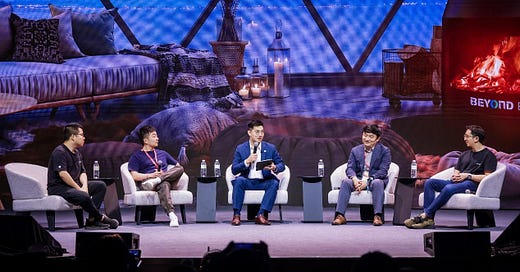





Great write up and summary of the expo, Grace. Thanks for covering it.
Thank you Grace, reading your work is like being there.